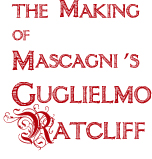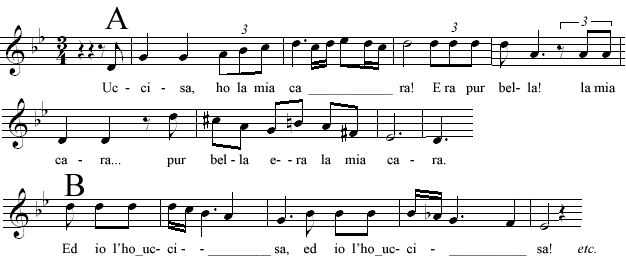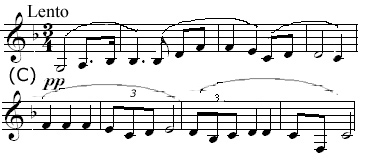 |
<< Previous
But faultless declamation and clever orchestral touches do not make an operatic masterpiece. That he had set himself an enormously difficult problem in choosing Heine's text Mascagni well knew, and he set about organizing the drama using purely musical resources. It will later be seen on just how large a scale this was accomplished, but at the moment we must turn our attention to the subject of recurring themes. When Mascagni said to Vichi that his Ratcliff resembles Verdi's Otello in the "intuition of sentiment" rather than in "actual phrases" he was undoubtedly thinking of his use of the two main motives which recur throughout the opera. The idea here is to have a theme of such poignancy that it not only reflects tht words and actions of the characters singing them at that moment, but that it intuits their thought to such a profound degree (thesis) that when it is presented again at the moment which is analogous in all respects (antithesis) to the preceding statement, the spectator himself will be moved almost in spite of himself, since his own emotions are now being called into play (synthesis). Where Verdi used only one such motive, Mascagni felt it necessary to use two.. The first of these represents the "frame" of the action, the ballad "Edward" which reappears at cucial moments and is sung only by the crazed Margherita. It has two halves and is presented as a whole immediately in the Prelude, sung behind the curtain, the second half (B) following the first (A):

It will be worth the listener's while to note the various moments, especially in Act Four, in which each of the two parts is sung in the drama.
But by far the most important theme is that which can conveniently be called the "Dream". It also has two parts. The first stands for both specters and appears at Ratcliff's words in Act Two: "vi sono strame orribili posse:"

The second signifies Ratcliff's own identification with the male spectre ("Er'io quel nubuloso uom," Act Two):

The phrase marked "C" will re-appear twice: in the orchestral peroration at the end of Act Three, when he has decided to do the spectre's will (he is here at the command of both of them); and in Act Four, when, after his suicide, the final phrase of "C" is played fortissimo by the full orchestra (he has done their bidding). "D" re-appears at one of the most crucial moments in Act Four, after he has killed Maria. It is this moment that Mascagni referred to in his letter of 2 August, 1886. This half is heard, significantly, before William's words, "T'arresta, e non fuggirmi, ombra di me medismo!" In one of the great inspirations of the opera (and which has become the most famous excerpt from the work), Mascagni combines the two halves for the first and only time: the famous "Ratcliff's Dream" in Act Three. It is a beautiful piece of music, but one which cannot be fully appreciated until one has heard it in context. Preceding its only appearance as a whole here in Act Three have been the isolated presentations of the two halves in Act Two. Now in the third act, with Ratcliff lying in a faint at the foot of the Black Rock, his own identification with one of the two spectres becomes becomes joined to their melody and his final decision as he revives, can logically be (to his fevered brain) to kill Maria, then himself, and fully become one with the spectres. Surely this is 'synthesis' on a grand scale!
This last example also points out one of Mascagni's favorite tropes, that of sharpening the penultimate note in a rising scale melody (such as the examples at  ). While it may seem like a passing aberration in his earlier works, it is an important part of his musical vocabulary and as such cannot be ignored.
It looks forward to the chromaticism of Isabeau and Parisina, in which the listener is asked to step out of the melodic framework momentarily. ). While it may seem like a passing aberration in his earlier works, it is an important part of his musical vocabulary and as such cannot be ignored.
It looks forward to the chromaticism of Isabeau and Parisina, in which the listener is asked to step out of the melodic framework momentarily.
It usually appears as part of a secondary theme, and has an—awkward feel to it, as though the very musical gesture were loath to finish the phrase, and took advantage of the last note available before completing the scale-like figure. We hear it in Cavalleria, in the Overture to I Rantzau, having its apotheosis perhaps in the tenor's refrain in the Cherry Duet from L'Amico Fritz. Certainly it appears in crucial places in Guglielmo Ratcliff as well. It appears in the above example during the Prelude, and develops during the "Dream" sequence; finally the ends of both Acts Two and Three have that extra chord in each of their final cadences, which give the phrase both a final lift and a chromatic cast that seems to come out of nowhere.
|